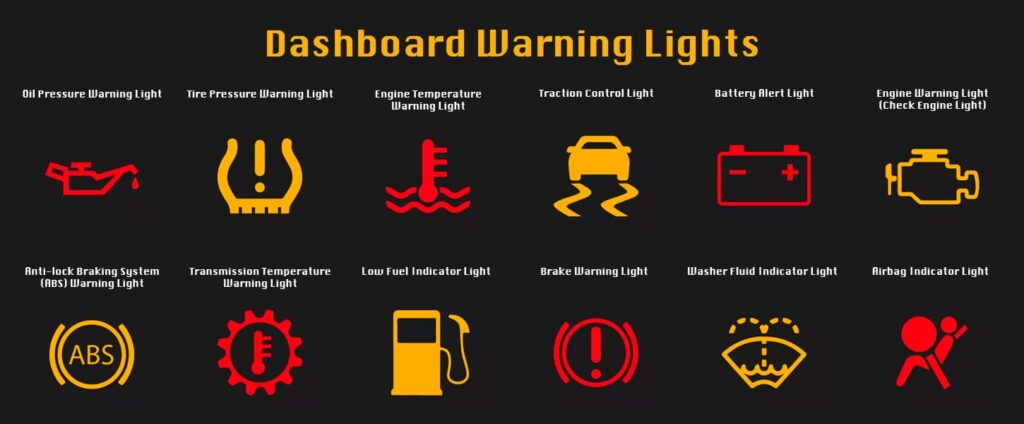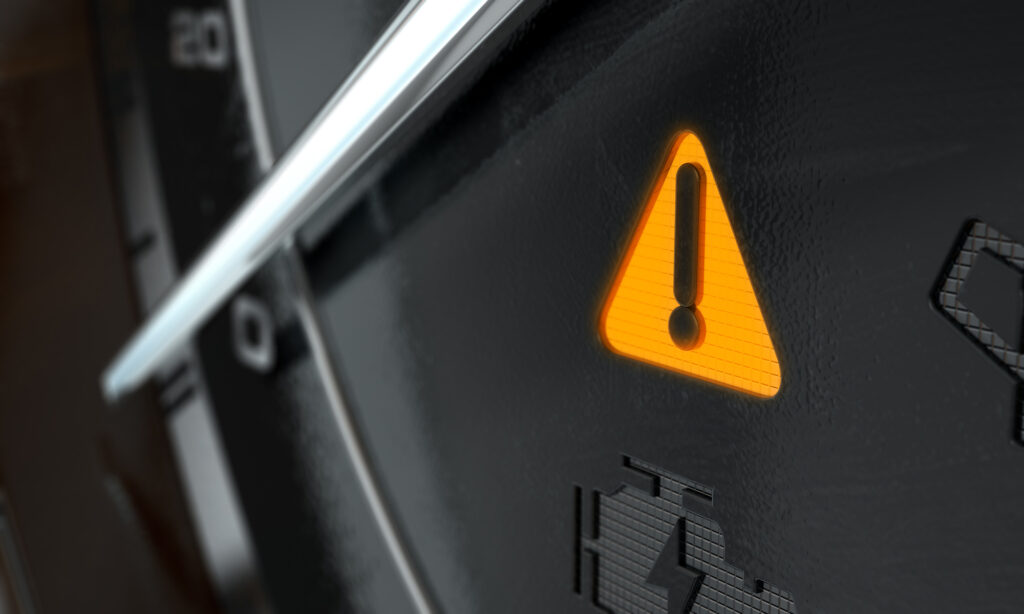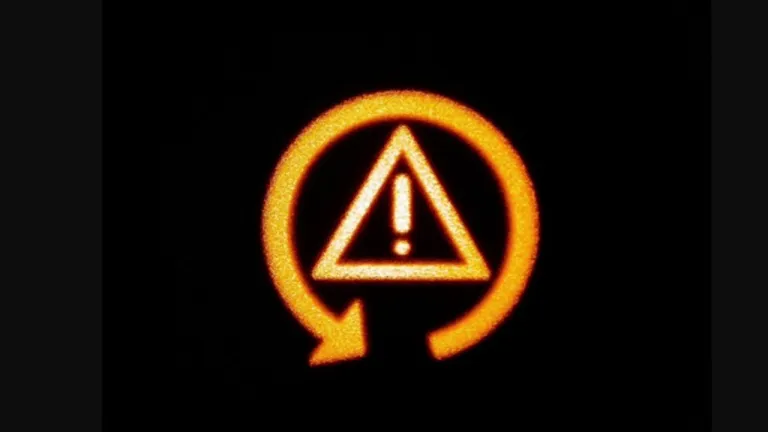The Triangle Light on your dashboard is a warning indicator that signals potential issues with your vehicle. The specific meaning can vary based on your car’s make and model. It commonly indicates problems related to the Traction Control System (TCS), Stability Control System, or other safety features.
When illuminated, it’s important to refer to your vehicle’s owner’s manual for precise information. A red or flashing Triangle Light may indicate a more critical issue, necessitating immediate attention and professional inspection.
What are common car dashboard symbols?

Common car dashboard symbols vary by make and model, but there are some universal symbols found in many vehicles. Here are a few examples:
Engine Warning Light: This light can illuminate for various reasons, from a loose gas cap to more complex engine issues. It’s a general indicator that something requires attention within the engine or its components.
Battery Light: When the battery light comes on, it suggests a problem with the charging system. This could be a failing battery, a malfunctioning alternator, or an electrical issue that needs prompt investigation.
Oil Pressure Warning: This symbol typically indicates low oil pressure, which could result from insufficient oil levels or a malfunctioning oil pump. Addressing this promptly is crucial to prevent engine damage.
Brake System Warning: Issues with the brake system trigger this warning. It may signal low brake fluid, worn brake pads, or a more serious problem that demands immediate attention to ensure braking effectiveness.
Tire Pressure Monitoring System (TPMS) Light: This light alerts you to low tire pressure in one or more tires. Maintaining proper tire pressure is vital for safety, fuel efficiency, and tire longevity.
Coolant Temperature Warning: An overheating engine is a serious issue that can lead to significant damage. This warning light indicates high coolant temperatures, urging you to address cooling system problems promptly.
Transmission Temperature Warning: If the transmission fluid temperature is too high, this light will illuminate. It signals potential issues with the transmission, such as inadequate fluid levels or cooling problems.
Airbag Warning: This light indicates a potential problem with the airbag system. Safety is paramount, and addressing airbag issues promptly is crucial for ensuring their functionality in the event of an accident.
ABS Warning: The Anti-lock Braking System (ABS) light indicates a problem with the ABS system. While the primary braking system may still function, the ABS, which helps prevent wheel lockup during hard braking, may be compromised.
Fuel Warning Light: When the fuel level is low, this light comes on, reminding you to refuel soon. Ignoring it could lead to running out of fuel, potentially stranding you on the road.
Why is there an exclamation mark in a triangle on my dashboard?

The appearance of an exclamation mark inside a triangle on your dashboard is a visual cue designed to draw your attention to a potential issue with your vehicle. While the exact meaning can vary between different car models, there are several common interpretations:
Traction Control System (TCS) or Stability Control System Warning
This symbol may illuminate to indicate a problem with the Traction Control System or Stability Control System. These systems are designed to enhance vehicle stability and control, especially during challenging driving conditions. If this light is on, it may suggest reduced traction or stability.
Brake System Warning
The exclamation mark in a triangle can also serve as a warning related to the brake system. It might indicate low brake fluid levels or issues with the brake components. It’s crucial to address brake-related warnings promptly to ensure the safety of your vehicle.
Tire Pressure Monitoring System (TPMS) Warning
In some vehicles, the exclamation mark in a triangle is associated with the TPMS, signaling low tire pressure in one or more tires. Proper tire pressure is vital for safety, fuel efficiency, and optimal tire performance.
General Warning Light
In certain instances, the exclamation mark may function as a general warning light, alerting you to a non-specific issue that requires attention. Additional context or accompanying lights may provide more information about the nature of the problem.
Why is there a triangle with an exclamation mark and ABS on my dashboard?

A triangle with an exclamation mark and ABS (Anti-lock Braking System) on your dashboard typically indicates a problem with the ABS system. The ABS system is a crucial safety feature that prevents wheel lockup during hard braking, enhancing vehicle control and stability.
The ABS warning light may illuminate to signal a malfunction within the ABS system. This could be due to issues with ABS sensors, the ABS module, or other related components.
In some cases, a low brake fluid level can trigger both the ABS and brake warning lights. Insufficient brake fluid can impact the proper functioning of the ABS system.
Problems with other components of the brake system, such as worn brake pads or a failing brake master cylinder, can lead to the illumination of the ABS warning light.
When you see the triangle with an exclamation mark and ABS, it’s essential to address the issue promptly.
- Ensure that the brake fluid level is within the recommended range. If it’s low, topping it up may resolve the issue temporarily, but it’s important to investigate and address the cause of the fluid loss.
- Check the condition of the brake pads, rotors, and other components. Worn brake pads or damaged ABS sensors could contribute to the warning.
- If the warning persists or if you’re unsure about the cause, it’s advisable to seek professional inspection. A qualified mechanic or an authorized service center can perform a diagnostic test to identify and resolve the ABS system issue.
How should drivers respond to Triangle Light warnings?
Responding to Triangle Light warnings on your dashboard requires prompt attention to address the underlying issues.
Consult your vehicle’s owner’s manual to understand the specific meaning of the Triangle Light warning. Different vehicles may have varied symbols and interpretations.
If the Triangle Light is accompanied by other warning lights, take note of them. Multiple lights can provide additional clues about the nature of the problem.
If the Triangle Light is red or flashing, it indicates a more critical issue. In such cases, address immediate safety concerns by pulling over to a safe location, turning off the engine, and assessing the situation.
For warnings related to brake, ABS, or other fluid systems, check fluid levels. Low brake fluid, for example, can trigger warning lights.
If the Triangle Light is related to the TPMS or traction control, check your tire pressures. Inflate or adjust as needed, and inspect tires for damage.
Until the issue is resolved, avoid aggressive driving behaviors, rapid acceleration, and abrupt braking to prevent exacerbating potential problems.
If you cannot identify or address the issue on your own, or if the warning persists, seek professional inspection. Visit an authorized service center or consult with a qualified mechanic to diagnose and repair the problem.
Ignoring warning lights, especially critical ones, can lead to further damage and compromise vehicle safety. Addressing issues promptly can prevent more extensive and costly repairs.:
If the Triangle Light is yellow or amber and not flashing, it may indicate a less critical issue. You can continue driving with caution, but it’s advisable to have the vehicle inspected at your earliest convenience.
When does the traction control system activate in a car?

The Traction Control System (TCS) in a car activates under specific conditions to enhance vehicle stability and prevent wheel spin. Here are common scenarios when the Traction Control System may activate
Acceleration on Slippery Surfaces
When you accelerate aggressively on slippery surfaces such as snow, ice, or wet roads, the TCS may intervene to prevent wheel spin. It modulates engine power or applies brake force to specific wheels to maintain traction.
Sudden Acceleration
Rapid acceleration, especially from a standstill, can lead to wheel spin. The TCS detects this and intervenes to ensure that power is delivered to the wheels more effectively, minimizing the risk of slipping.
Cornering at High Speeds
During high-speed cornering, if the TCS senses that one or more wheels are losing traction, it can apply brakes selectively to specific wheels to help the vehicle maintain stability.
Uneven Road Surfaces
Driving on uneven surfaces, such as a road with one side covered in ice, can lead to differences in wheel traction. The TCS works to balance the power distribution between wheels to prevent skidding or loss of control.
Off-Road Driving
In certain vehicles equipped with off-road Traction Control Systems, the TCS activates when driving on challenging off-road terrain. It helps manage wheel spin and ensures optimal traction on uneven surfaces.
Sudden Deceleration
When decelerating rapidly, such as during hard braking or on a steep downhill slope, the TCS can intervene to prevent wheel lockup and maintain stability.
FAQ
What does the triangle light mean on a VW Dash?
The triangle light on a VW dashboard signals issues with Electronic Stability Control or Traction Control System, emphasizing the need for reference to the owner’s manual.
What is the triangle light on my Toyota dashboard?
The Toyota dashboard’s triangle light is linked to Vehicle Stability Control, indicating a potential problem that requires careful driving. Referencing the Toyota owner’s manual provides more accurate details.
What does this warning light on the dash mean?
The meaning of a warning light varies, signifying issues like engine problems or brake issues. Identifying the symbol and consulting the owner’s manual is essential for understanding the specific concern.
What are 3 warning lights in a car?
Common car warning lights include Check Engine Light (engine issues), Brake System Warning Light (brake problems), and Oil Pressure Warning Light (low oil pressure), each necessitating prompt attention.
What is the most serious warning light?
The Check Engine Light is often considered the most serious, indicating a range of engine issues, some of which may require immediate attention to prevent further damage.
Can I drive with a warning light on?
While some warning lights indicate less critical issues, it’s generally not advisable to drive with any warning light illuminated. Promptly addressing the issue and seeking professional inspection is recommended.
What are the 2 main types of dashboard warning lights?
Dashboard warning lights fall into two main types: indicator lights (system status) and warning lights (potential issues). Understanding these distinctions aids in interpreting dashboard signals.
Can I still drive with a warning light?
Driving with a warning light depends on the specific light and its severity. Red or flashing lights often indicate critical problems, requiring minimized driving until the issue is resolved.
Final thoughts
In conclusion, knowing what the Triangle Light on your dashboard means is important for keeping your car safe. If it lights up, check your owner’s manual to understand the issue and fix it quickly. Whether it’s about traction control or other safety stuff, taking action fast is vital, especially if the light is red or flashing.
Get professional help to figure out and solve the problem. Regular check-ups and understanding your car’s symbols help you drive without worries and make your car last longer. Drive safely, know your car, and enjoy your trips!

